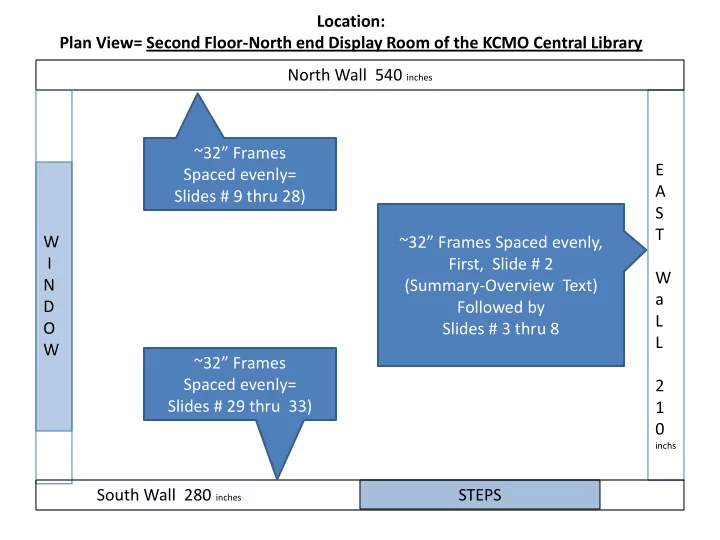

Location: Plan View= Second Floor-North end Display Room of the KCMO Central Library North Wall 540 inches ~32” Frames E Spaced evenly= A Slides # 9 thru 28) S T W ~32” Frames Spaced evenly, I First, Slide # 2 W N (Summary-Overview Text) a D Followed by L O Slides # 3 thru 8 L W ~32” Frames Spaced evenly= 2 Slides # 29 thru 33) 1 0 inchs South Wall 280 inches STEPS
The Bannister Federal Complex Today The History of the site and how it changed with time Follows on the next xx photos
“Kansas City Missouri - For Speed and Defense” The Bannister Federal Complex(BFC) Story A Kansas City Legacy from World War II (First built in 1942 for Kansas City’s “Pratt & Whitney (P&W) Plant”)
Before there was a Bannister Federal Complex and Pratt & Whitney plant. A Racetrack known as the “KC Speedway” was built at the plant’s location in 1922. It was big time racing with big names, as indicated the August 27, 1922 article from the New York Times.
Then came World II and the “Pratt & Whitney Plant” • The largest of the many World War II defense production facilities in the Kansas City area was the built by the US Government at the request of the US Navy. It was located at 95 th (Bannister Rd) and Troost. • Although it was owned by the US Government’s Department of the Navy, it was known locally as the “Pratt & Whitney Plant”, after its operating contractor. • At peak production in 1944-1945, the plant employed more than 21, 000 people (about 7000 per shift working 3 shifts a day, 7 days a week). It built the Pratt & Whitney R-2800 Double Wasp airplane engine for US Navy fighters. It employed almost 10% of the Kansas City area population during that time. • That building, together with several adjoining facilities built after WWII, is currently known as the Bannister Federal Complex and is owned by the US government. Portions are occupied by the GSA, NARA and other government agencies. • A major portion occupied by the National Nuclear Security Administration(NNSA) and its contractor (Honeywell Federal Manufacturing and Technologies-FM&T) continues in defense production still today in 2009, continuing its original mission to help defend and protect the people of America and the free world. • This Exhibit is the story of that site, its building, past and present missions, and its remarkable people and its possible future.
The Plant: The Plant: at it looked in 1945 at the as it looks in 2009 end of WWII
The Vought Corsair One of the Fighters that incorporated the Pratt &Whitney R-2800 Engine produced at the Plant.
The Republic Thunderbolt One of the Fighters that incorporated the Pratt &Whitney R-2800 Engine produced at the Plant.
The Grumman Bearcat One of the Fighters that incorporated the Pratt &Whitney R-2800 Engine produced at the Plant.
The Atomic Bomb and the End of World War II The atomic bombs dropped on Japan ended World War 2 and the plant closed on W-J Day, September 2, 1945. The P&W plant played no role in the Manhattan project that developed the bombs, but in 1949 a contractor to the US Atomic Energy Commission (Bendix) began to support the US post war nuclear weapons program. A successor contractor (Honeywell Federal Manufacturing & Technologies) continues to make non-nuclear weapons components to this day.
The Empty Plant: 1945-1949 The plant was idle from 1945 to 1949, except for use to store war surplus (tires, sugar, etc) . Some space was also used by local contactors such as the Lingle Refrigeration who produced commercial products as walk-in coolers for food storage
The Banshee Jet Engine Powered Fighter
The J34 Jet Engine-produced by the Westinghouse Aviation Jet Engine Company of Missouri (from 1949 to 1960)
The Panther Jet Engine Powered Fighter
The Goblin Jet Engine Powered Drone Plane
The J34 Jet Engine-produced by the Westinghouse Aviation Jet Engine Company of Missouri (from 1949 to 1960)
This schematic picture shows the parts of the engine that fed fuel to and powered to jet
Picture # 1 of two pictures showing the important lubrication sub-system of the J34 engine. This schematic picture shows the parts of the engine that lubricated the moving parts in the jet engine, and includes the color code legend that identifies various parts of the lubrication flow (See next picture also).
Picture # 2 of two pictures showing the important lubrication sub-system of the J34 engine. This schematic picture shows the parts of the engine that lubricated the moving parts in the jet engine.
The pieces of the J34 jet engine-Details shown in the next xx pictures
The J46 Successor to the J34 Jet Engine
A surplus J34 jet engine was used to propel several jet-powered racing cars after it was no longer used by the Navy in fighter planes.
Recommend
More recommend